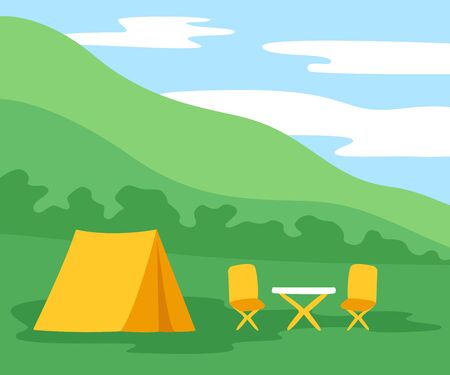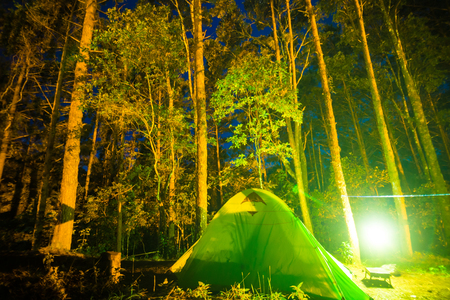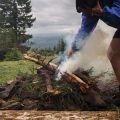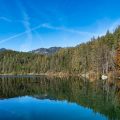Introduction: The Magic of Spring Wildlife Watching
Spring in the United States is a season of transformation—melting snow, blooming wildflowers, and, most exciting for many campers, the return of active wildlife. Whether you’re pitching your tent in a national park or setting up camp in a state forest, spring offers some of the best opportunities to observe animals in their natural habitats. Here’s why this season stands out and how you can make the most of your wildlife watching adventures while camping.
Why Spring Is the Prime Season for Wildlife Observation
As temperatures rise and days grow longer, animals shake off winter’s chill. Birds migrate back north, mammals emerge from hibernation, and many species begin nesting or raising their young. This makes spring a dynamic time to spot everything from songbirds to deer, foxes, and even black bears. Many creatures are more visible as they search for food or mates, making sightings much more likely than during other seasons.
What You Might See While Spring Camping
| Type of Animal | Common Examples | Where to Look |
|---|---|---|
| Birds | Warblers, bluebirds, woodpeckers | Treetops, meadows, near water sources |
| Mammals | Deer, rabbits, black bears (in some regions) | Forest edges, clearings, near rivers/streams |
| Amphibians & Reptiles | Frogs, salamanders, turtles | Ponds, wetlands, under logs or rocks |
| Insects & Pollinators | Butterflies, bees, dragonflies | Flower-filled meadows, sunny trailsides |
Quick Tips for Responsible Wildlife Watching
- Keep Your Distance: Always use binoculars or a camera zoom rather than getting too close.
- No Feeding: Don’t offer food—human snacks are unhealthy for wild animals and can make them dependent.
- Stay Quiet: Move slowly and speak softly to avoid startling animals.
- Leave No Trace: Pack out all trash and respect habitats by sticking to established trails.
- Observe at Dawn or Dusk: Many animals are most active during these times.
The magic of spring wildlife watching lies in seeing nature wake up all around you. With the right approach and some patience, your next camping trip could become an unforgettable window into the wild world that thrives just beyond your tent flap.
2. Top American Wildlife to Watch for This Spring
Spring camping in the U.S. isn’t just about fresh air and blooming wildflowers—it’s also prime time for spotting some of North America’s most iconic animals. As the weather warms up, wildlife comes out of winter hiding, making it easier than ever to catch a glimpse of them in their natural habitats. Here are some top animals you might see while camping this spring:
Deer
White-tailed deer and mule deer are among the most common sights in American forests and meadows during springtime. You’ll often spot them grazing at dawn or dusk near open fields or forest edges. Their fawns are usually born in late spring, so keep an eye out for these adorable newcomers—but remember to observe from a distance!
Elk
If you’re camping near national parks or forests in the western states, elk herds become especially active in spring. They move into lower elevations as snow melts, making them easier to spot in valleys and meadows. Early morning is your best bet for sightings.
Migratory Birds
Spring brings a burst of bird activity as migratory species return north. Songbirds, waterfowl, and even raptors can be seen in large numbers across many states. Bring binoculars and listen for unique calls—birdwatching is rewarding whether you’re new or experienced.
Popular Migratory Birds to Watch
| Bird Species | Where to Spot Them |
|---|---|
| American Robin | Parks, gardens, and open woods across the U.S. |
| Baltimore Oriole | Eastern woodlands and suburban areas |
| Western Tanager | Mountain forests in the West |
| Sandhill Crane | Wetlands in the Midwest & Great Plains |
| Ruby-throated Hummingbird | Southeastern states moving northward |
Black Bears
As black bears wake from hibernation, they roam widely searching for food. While generally shy, they can sometimes be seen at dawn or dusk near streams or berry patches—especially in national parks like Great Smoky Mountains or Yellowstone. Always practice safe wildlife viewing: never approach bears and properly store your food!
Quick Tips for Safe Wildlife Watching
- Keep a respectful distance—use binoculars or a camera zoom.
- Avoid feeding animals; it’s unsafe for both you and them.
- Stay quiet and move slowly to avoid startling wildlife.
- Follow campground rules for food storage to keep bears away.
This spring, take advantage of longer days and warmer weather by keeping an eye out for these amazing animals during your camping adventures!

3. Best U.S. Regions and Campsites for Wildlife Encounters
Spring camping in the United States is a fantastic way to see wildlife in action. Different regions offer unique animal sightings, from elk herds in the Rockies to alligators in the Southeast. Here’s a practical breakdown of prime areas and some recommended campsites where your chances of spotting native wildlife are high.
Pacific Northwest
The Pacific Northwest is famous for its lush forests, rugged coastlines, and diverse ecosystems. Here, you can spot black bears, bald eagles, Roosevelt elk, and even migrating gray whales along the coast.
| Campsite | State | Wildlife Highlights |
|---|---|---|
| Olympic National Park – Hoh Campground | Washington | Roosevelt elk, river otters, bald eagles, banana slugs |
| Fort Stevens State Park | Oregon | Migrating gray whales, sea lions, deer, shorebirds |
Rocky Mountains
The Rockies are a classic destination for wildlife lovers. Spring brings out moose calves, bighorn sheep, marmots, and sometimes even grizzly bears emerging from hibernation.
| Campsite | State | Wildlife Highlights |
|---|---|---|
| Moraine Park Campground (Rocky Mountain National Park) | Colorado | Elk herds, mule deer, coyotes, wild turkeys |
| Mammoth Campground (Yellowstone National Park) | Wyoming/Montana border | Bison, pronghorns, black bears, wolves (distant) |
Southeast U.S.
The Southeast offers a subtropical environment with its own unique animals. From manatees to alligators and colorful migratory birds, spring here is lively and full of surprises.
| Campsite | State | Wildlife Highlights |
|---|---|---|
| Everglades National Park – Long Pine Key Campground | Florida | Alligators, manatees (nearby), roseate spoonbills, turtles |
| Cades Cove Campground (Great Smoky Mountains National Park) | Tennessee/North Carolina border | White-tailed deer, black bears (from a distance), wild turkeys, salamanders |
Midwest & Great Lakes Region
This region shines in springtime with vast wetlands and woodlands supporting waterfowl migrations and forest mammals waking up for the season.
| Campsite | State | Wildlife Highlights |
|---|---|---|
| Itasca State Park Campgrounds | Minnesota | Bald eagles, white-tailed deer, beavers, loons (Minnesota’s state bird) |
| Pictured Rocks National Lakeshore – Hurricane River Campground | Michigan (Upper Peninsula) | Bald eagles, foxes, black bears (rare), warblers during migration season |
Tips for Wildlife Watching at Campgrounds:
- Dawn and dusk are prime times: Most animals are active early or late in the day.
- Be quiet and patient: Move slowly and listen; you’re more likely to see wildlife if you blend in.
- Keep food stored securely: This protects both you and local wildlife—never feed wild animals.
Your Gear Checklist:
- Binoculars or spotting scope for distant viewing
- Pocket field guide or phone app for quick animal identification
- A camera with zoom lens if you want to capture those moments
If you plan your trip around these regions and campgrounds this spring, you’ll boost your odds of memorable wildlife encounters. Each site has its own specialties—so choose what excites you most!
4. Essential Gear & Safety Tips for Wildlife Watching
Must-Have Gear for Wildlife Watching
If you’re heading out for some wildlife watching while spring camping, having the right gear can really make a difference. Here’s a quick look at what you should pack:
| Gear | Purpose | Recommended Features |
|---|---|---|
| Binoculars | Get a closer look at animals without disturbing them | Lightweight, waterproof, 8×42 or 10×42 magnification |
| Field Guides (Books or Apps) | Identify local birds, mammals, and plants | Pocket-sized, regional focus, easy-to-use index or search |
| Camera/Smartphone | Capture memories and document sightings | Zoom lens or good digital zoom, silent mode option |
| Notebook & Pencil | Record observations and sketch animals or tracks | Weatherproof paper is a plus |
| Comfortable Backpack | Carry all your gear hands-free during hikes | Padded straps, water-resistant material, multiple pockets |
| Clothing in Earth Tones | Blend into surroundings and avoid startling wildlife | Breatheable fabrics, layers for changing weather |
| Bug Spray & Sunscreen | Stay comfortable and safe outdoors | DEET-free options available; SPF 30+ |
Safety Tips for Campers and Wildlife Alike
Be Respectful—Keep Your Distance
- Observe quietly: Sudden movements and loud noises can scare animals away or even provoke defensive behavior.
- No feeding: Feeding wildlife can harm their health and make them dependent on humans.
- Avoid nesting areas: Stay on marked trails to prevent disturbing habitats, especially during breeding season.
- Use binoculars: Binoculars let you enjoy close-up views without getting too near.
Protect Yourself in the Wild
- Store food properly: Use bear-proof containers or hang food at least 10 feet off the ground and away from your tent.
- Keep a safe distance: If an animal notices you and changes its behavior, you’re too close—back away slowly.
- Campsite cleanliness: Pack out all trash to avoid attracting unwanted visitors like raccoons or bears.
- Dress for safety: Long sleeves and pants protect from ticks and poison ivy; bright orange gear is smart in hunting areas.
- First aid kit: Always carry one with supplies for bites, stings, and allergic reactions.
- Keen awareness: Learn about local species—know which animals to avoid (like snakes or large mammals) and how to respond if you encounter them.
Your Wildlife Watching Checklist:
- Packed binoculars & field guide?
- Sunscreen and bug spray applied?
- Campsite free of food scraps?
- Dressed in earth tones with sturdy shoes?
- First aid kit ready to go?
- Sightings logged in your notebook?
The right gear and some basic safety habits help ensure that both you and the wildlife have a great experience during your spring camping adventure.
5. How to Observe Without Disturbing: Responsible Wildlife Etiquette
Watching wildlife while spring camping is an amazing experience, but it’s important to protect both the animals and their habitats. Here’s how you can enjoy nature respectfully and responsibly.
Keep Your Distance
Always use binoculars or a camera with a zoom lens instead of getting closer to wildlife. Getting too close can stress animals and even change their behavior. Stay on designated trails and never approach nests, dens, or young animals.
Leave No Trace Principles
The Leave No Trace (LNT) principles are key for minimizing your impact while enjoying the outdoors. Here’s a quick overview:
| LNT Principle | How It Applies to Wildlife Watching |
|---|---|
| Plan Ahead and Prepare | Research local wildlife and regulations before your trip. |
| Travel and Camp on Durable Surfaces | Stick to established trails and campsites to avoid disturbing habitats. |
| Dispose of Waste Properly | Pack out all trash, leftover food, and litter to keep animals safe. |
| Leave What You Find | Don’t pick plants or move natural objects that animals rely on. |
| Minimize Campfire Impact | Use camp stoves instead of fires when possible; avoid collecting wood from the area. |
| Respect Wildlife | Observe quietly from a distance; do not feed or attempt to touch any animals. |
| Be Considerate of Other Visitors | Share the space respectfully and help others spot wildlife without crowding. |
Follow Local Regulations
Laws about wildlife watching can vary by state park, national forest, or other public lands in the U.S. Some areas may have seasonal closures or restrictions to protect sensitive species. Always check posted signs or ask a ranger if you’re unsure what’s allowed.
Quick Tips for Responsible Wildlife Watching:
- Avoid loud noises—keep conversations quiet and silence your phone.
- If you bring pets, keep them leashed and away from wildlife areas.
- Avoid using artificial lights or flashes when photographing animals at night.
- If an animal changes its behavior because of your presence (like running away or making alarm calls), you’re too close—back up slowly.
- Never feed wild animals; human food is unhealthy for them and can cause dependency.
Your actions matter!
A little care goes a long way toward preserving America’s wild spaces for future generations of campers and creatures alike.
6. Fun Activities and Learning Opportunities for All Ages
Spring camping is the perfect time to connect with wildlife and nature, especially when everyone—kids and adults alike—can join in hands-on activities. Here are some interactive ideas to make your wildlife watching adventure even more memorable:
Wildlife Tracking: Become a Nature Detective
Bring out your inner explorer by looking for animal tracks, scat, or other signs of wildlife around your campsite. This activity turns any hike into a scavenger hunt and helps campers of all ages learn to identify the animals sharing the outdoors with them.
| Track/Sign | Possible Animal | Where to Look |
|---|---|---|
| Small paw prints | Raccoon, fox | Muddy trails, near streams |
| Deer hoof prints | White-tailed deer | Open fields, forest edges |
| Nibbled pine cones | Squirrel, chipmunk | At the base of trees, picnic areas |
| Feathers or nests | Songbirds, owls | Trees, shrubs, under branches |
Photography: Capture Springs Wild Moments
No fancy gear required! Use your smartphone or a basic camera to snap photos of animals, flowers, insects, or scenic views. Try setting a challenge: Who can photograph the most different birds? Or see who finds the most colorful wildflower. These snapshots become great memories—and maybe even a fun slideshow back at camp.
Tips for Great Wildlife Photos:
- Move slowly and quietly—patience pays off!
- Early mornings and evenings are best for spotting animals.
- Avoid using flash as it may disturb wildlife.
- Respect boundaries; never approach too closely.
Journaling: Make Your Own Nature Diary
Encourage everyone to keep a nature journal during your trip. Campers can jot down what animals they see, sketch plants or birds, or record interesting sounds they hear (like frogs croaking or woodpeckers drumming). For younger kids, provide simple prompts or let them use stickers and colored pencils.
Nature Journal Prompt Ideas:
- Draw the coolest track you found today.
- Write about your favorite animal sighting.
- List five different bird calls you heard.
- Create a map of where you spotted wildlife around camp.
Why These Activities Matter
Trying these hands-on activities not only makes spring camping more fun but also helps everyone slow down and really notice the wonders around them. From tracking to photography and journaling, these experiences create lasting memories while deepening appreciation for America’s wild places.


